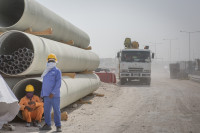Opinion
Understanding resilience
It is easy to admire the Hindu Kush Himalaya (HKH) as a geographical region with beautiful natural scenery. However, it is also important to remember that the abundance of natural resources in the HKH sustains the livelihoods of more than 1.3 billion people.
Sakhie Pant
It is easy to admire the Hindu Kush Himalaya (HKH) as a geographical region with beautiful natural scenery. However, it is also important to remember that the abundance of natural resources in the HKH sustains the livelihoods of more than 1.3 billion people. The region, which spans across Afghanistan, Bangladesh, Bhutan, China, India, Nepal, Myanmar, and Pakistan, is rich in terms of biodiversity hotspots, eco-regions and water supply, and food production and energy generation.
Apart from its distinct ecological features, the region has mountain specificities. These characteristics include inaccessibility, fragility, marginality, diversity, niche biological opportunities, and human adaptation mechanisms. The remote geographical location, vulnerable environment with increasing threat of climate change, and distance from mainstream society, make the region one of the poorest in the world, with 61 million people living below the poverty line.
Addressing vulnerability
The unavoidable structure of the HKH and recent changes in the region require the implementation of approaches to strengthen resilience building as it is a valuable asset for mountain people. Resilience is the ability of an individual to successfully cope with and adapt to change and improve their livelihood choices and opportunities despite environmental instability. However, resilience has been addressed mostly in managerial or technical ways. This method has helped people adapt to challenges, but it pays little attention to the mental and emotional well-being of mountain people and fails to acknowledge the internal struggles they go through.
The struggle begins with geographical disparity. The HKH is located in a region where the ‘majority’ interest of the political, economic, and social focus shadows the needs of mountain people and fails to allocate resources for them, compromising their claim for redistribution and reallocation. This structural phenomenon has been creating and reinforcing the cycle of poverty amongst mountain people, limiting their influence in society with their minority status and failing to acknowledge their competences.
This structure has been accepted as being reflective of the normal way of life in the mountains. It has been persistent and passed down from generation to generation—captured in a set of beliefs, values, and abilities. This experience of vulnerability not only affects the social and physical well-being of mountain people but also has detrimental effects on their psychological wellbeing. Due to the struggles associated with maintaining their livelihood while coping with the changing environment, mountain people are more prone to feel hopeless and fatalistic, and may develop mental health consequences such as anxiety, depression, and post-traumatic stress disorder as a result. While struggling to cope with both internal and external obstacles, the resilience of mountain communities is affected severely as they are overcome by stress and frustration. This leads to a tendency among mountain people to focus only on immediate goals and ignore long-term ones.
Building strength
In order to build resilience, first, there needs to be awareness that resilience is not a trait but rather a process of learning and of adapting to changes in the face of climate change. This ability then needs to be manifested in behaviour, where mountain communities need to come together and practise resilience to cope with changes for future well-being, as resilience is not only a mental outlook but also a community effort. The process of resilience building takes place in many forms—ranging from disaster risk management, biodiversity conservation, and water management to livelihood diversification and income-enhancing activities, including migration, among others.
The progress of resilience building is reflected in the Resilient Mountain Villages of the HKH where the effects of climate change are dealt with through approaches such as recycling wastewater, identifying high-value product value chains, and improving and diversifying vegetable harvest with the help of bio-fertilisers such as ‘jholmal’.
Furthermore, for improved resilience, efforts have been made to integrate geographical information systems (GIS) and the knowledge of local villagers to help identify local strategies and analyse people’s perceptions of coping mechanisms so that they may become empowered and able to deal with disasters triggered by changes in the environment. This has proven especially beneficial to certain social groups such as women, children, the elderly, the disabled, and minorities who face additional challenges because of their social position, leaving them more vulnerable to depression.
There is a need to achieve better understanding of the changes taking place in the HKH and strengthen resilience building approaches not only from a mountain perspective but also to successfully achieve sustainable development goals. At present, changes and resilience building efforts in relation to mountain people are recognised mainly under three heads: climate resilience, socio-economic resilience, and future resilience, representing solutions only to external challenges. For a comprehensive resilience-building approach, an understanding of the internal challenges that mountain communities face is equally crucial. After all, the strength to cope with change and muster preparedness for adaptation both begin within.
- Pant is an intern at the International Centre for Integrated Mountain Development (ICIMOD)




 19.12°C Kathmandu
19.12°C Kathmandu










%20(1).jpg&w=300&height=200)

